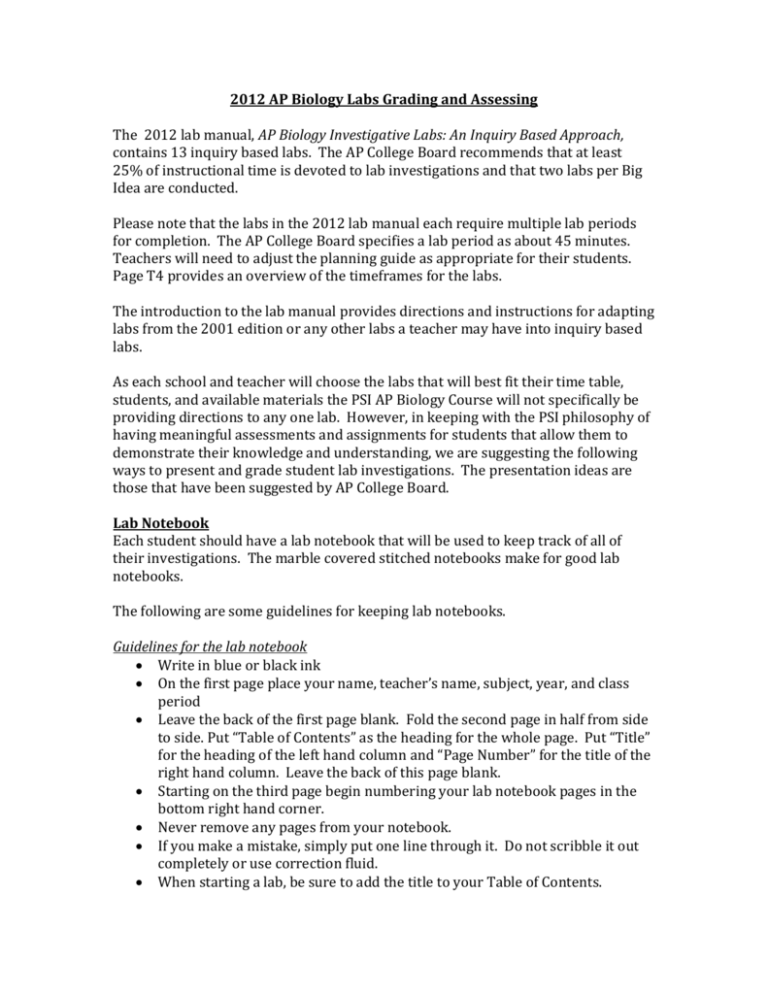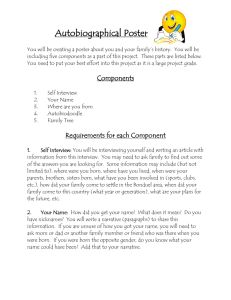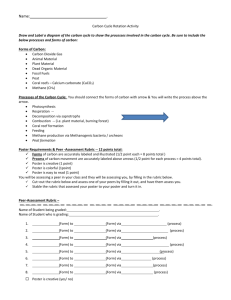2012 AP Biology Labs Grading and Assessing The 2012 lab manual
advertisement

2012 AP Biology Labs Grading and Assessing The 2012 lab manual, AP Biology Investigative Labs: An Inquiry Based Approach, contains 13 inquiry based labs. The AP College Board recommends that at least 25% of instructional time is devoted to lab investigations and that two labs per Big Idea are conducted. Please note that the labs in the 2012 lab manual each require multiple lab periods for completion. The AP College Board specifies a lab period as about 45 minutes. Teachers will need to adjust the planning guide as appropriate for their students. Page T4 provides an overview of the timeframes for the labs. The introduction to the lab manual provides directions and instructions for adapting labs from the 2001 edition or any other labs a teacher may have into inquiry based labs. As each school and teacher will choose the labs that will best fit their time table, students, and available materials the PSI AP Biology Course will not specifically be providing directions to any one lab. However, in keeping with the PSI philosophy of having meaningful assessments and assignments for students that allow them to demonstrate their knowledge and understanding, we are suggesting the following ways to present and grade student lab investigations. The presentation ideas are those that have been suggested by AP College Board. Lab Notebook Each student should have a lab notebook that will be used to keep track of all of their investigations. The marble covered stitched notebooks make for good lab notebooks. The following are some guidelines for keeping lab notebooks. Guidelines for the lab notebook Write in blue or black ink On the first page place your name, teacher’s name, subject, year, and class period Leave the back of the first page blank. Fold the second page in half from side to side. Put “Table of Contents” as the heading for the whole page. Put “Title” for the heading of the left hand column and “Page Number” for the title of the right hand column. Leave the back of this page blank. Starting on the third page begin numbering your lab notebook pages in the bottom right hand corner. Never remove any pages from your notebook. If you make a mistake, simply put one line through it. Do not scribble it out completely or use correction fluid. When starting a lab, be sure to add the title to your Table of Contents. At the start of a lab you should include the title, date, and the name of your lab partner. Your lab notebook is a space to keep your notes both formal and informal. You can use it to keep track of data, perform your calculations, and keep track of any questions you may think of while conducting your investigation. All lab parts: questions, hypothesis, experimental design, relevant background info, safety precautions, data tables, graphs, analysis, and conclusions will be written in your notebook. If you complete a graph on the computer, you should paste the graph into your notebook at the appropriate location. You may want to leave pages between the end of one lab and the start of another lab incase you decide to go back and add any information. Please write legibly! Each teacher can provide more instruction on the specific format they may wish for students to use or they can provide examples and allow students to make the choice. Lab notebooks will be collected periodically by teachers with prior notice to students and labs will be graded using the same rubric that will be used for the mini poster presentation. The rubric for grading can be found at: http://www.nabt.org/blog/wpcontent/uploads/2010/04/RUBRIC.pdf The difference is that the scale will be adjusted from 5, 3, and 1 point to 3,2, and 1 points. Therefore the maximum number of points a lab is worth would be 42points. Notebooks should be collected after all labs from a Big Idea are completed. Students should place a sticky note on the lab from that Big Idea that they think they have done exceptionally well on keeping notes on, and that is the lab that will be assessed by the teacher. This eliminates having to do “make up” labs for students who were absent. It also allows students to improve their work and decide which of their samples was best. There are no “retakes” for this assignment as students should be given the rubric ahead of time to use for self-assessment and are allowed to choose which lab is being assessed. You could also encourage students to have their peers assess their work, before submitting it to the teacher. Mini Posters & Presentations For one of the labs that students conduct in relation to Big Idea 2, students will complete a mini poster and presentation. Students may do this individually or with their lab partner. Students should be given the option to choose to do the poster from any of the labs they have conducted for Big Idea 2. For ideas on how the mini poster should be assembled, please see: http://www.nabt.org/blog/2010/05/04/mini-posters-authentic-peer-review-inthe-classroom/ The use of sticky notes, makes this project easily revisable. The rubric for grading can be found at: http://www.nabt.org/blog/wpcontent/uploads/2010/04/RUBRIC.pdf The presentation should ideally occur the day after the unit test. Before the presentation day, teachers may need to provide examples and instructions for what a poster session looks like; i.e. what the roles of the presenters and the critical audience are. During the presentation each poster should have 3-5 rubrics completed by the peers within the class and given to the poster owners at the end of the session. Students should then be given up to 1 week to make any changes and to their posters and to submit the poster and rubrics from peers to their teacher. In addition, each students individually should provide a paragraph or up to 1 page explanation of what if any improvements were made and why. If no improvements were made, they should also include why they chose not to include any and what the strengths of their presentations were. Grading the explanation: Advanced- 5 points: Student was able to identify the strengths and weaknesses of his/her presentation. Student was able to identify and defend what caused them to make any changes or why they chose not to make any changes. Student was able to express the value of presenting to his/her peers and what they learned from the experience. Proficient- 3 points: Student was able to identify the strengths and weaknesses of his/her presentation. Student was identified changes made. Needs Improvement: 1 point: Student identified the changes made. The poster, the rubrics from the other students, and the explanation all need to be handed in, in order for the poster to be graded. The teacher will grade the poster using the same rubric the students used. The rubric provides for a possible 70points and the explanation for an additional 5 points. The assignment will count for 75points and will not be curved. There is no opportunity for a make-up grade for this assignment as students are given the feedback from their peers to make improvements before handing in their project to their teacher. If any students are absent on the presentation day, they have until the submission due date to ask their classmates to review their poster and presentation. Formal Lab Report For one of the labs conducted in relation to Big Idea 3, students will complete a formal lab report. This assignment will be completed individually. Students should be given the option to complete the lab report for any of the labs they have conducted in relation to Big Idea 3. Teachers will need to show examples of a formal lab report and provide explanation for what is expected. Please see the 2012 AP lab manual for a rubric for grading on pg.T42 at: http://media.collegeboard.com/digitalServices/pdf/ap/biomanual/CB_Bio_TM_SM_intros_WEB_1_24_12.pdf As suggested in the manual, students should complete a rubric to hand in with their report. Teachers will use this rubric to assess the reports. The due date should be after the unit test. Students should be given the opportunity to resubmit their reports with improvements after receiving their initial grade. This is similar to the idea of a “re-take” for quizzes and tests. This assignment will count for 100points. *For Big Idea 4, students should be given the choice to complete a mini poster & presentation or a formal lab report for one of the labs they have conducted for Big Idea 4. If different students in your class choose different assignments, you can convert the grade from the mini poster presentation from its value out of 75points to the equivalent value out of 100points, this will make it easier for you to insert in your grade book.






